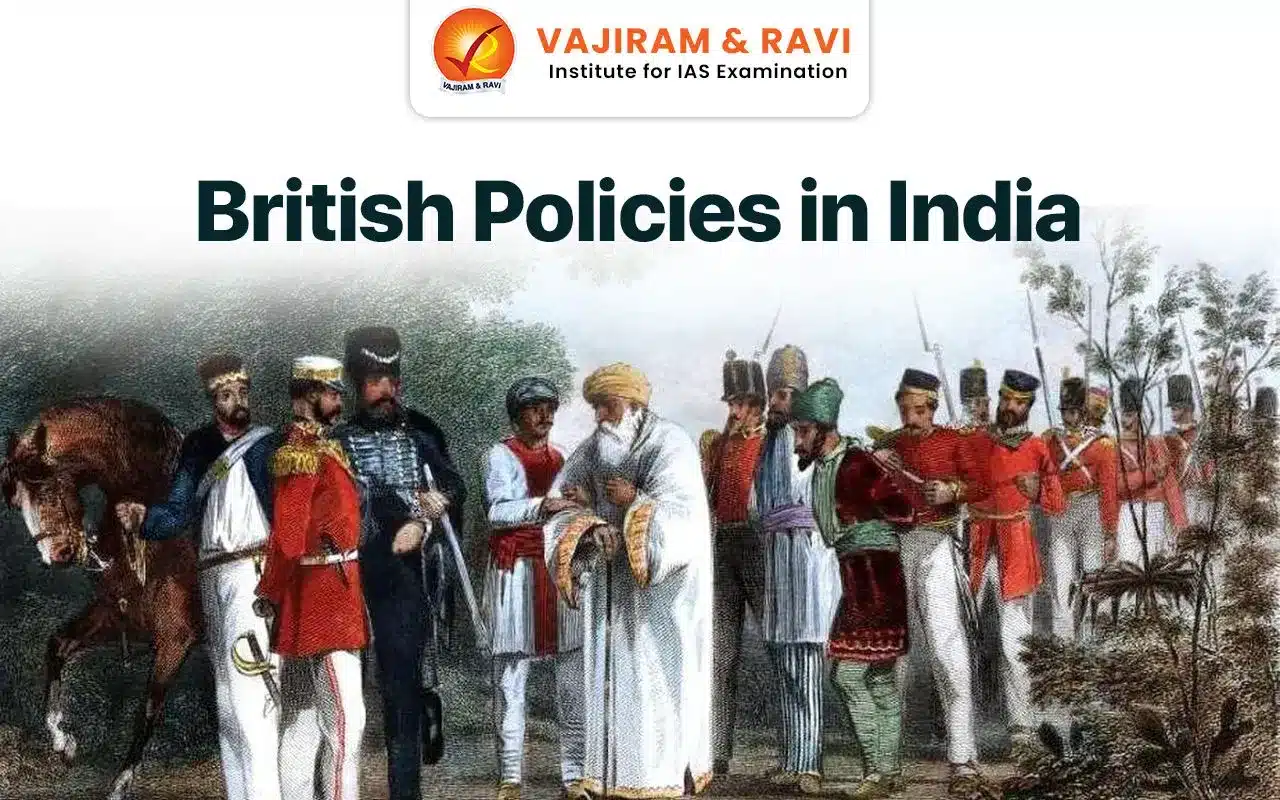The British policies in India had a profound impact on various aspects of society, shaping its administrative, economic, and socio-cultural landscape. The centralised bureaucracy and uniform legal system transformed governance. Economically, British policies exploited India’s resources, causing deindustrialisation. Socio-culturally, English education and Western ideas influenced a modern intellectual class, while traditional structures faced preservation and distortion.
The Industrial Revolution and intellectual shifts in Britain influenced their attitudes. Concepts like liberty, equality, and human rights emerged amidst social issues like sati and child marriages. Legal reforms introduced aiming to improve women’s status. The colonial legacy continues to impact on overall India’s trajectory.
British Administration and Governance
The British administration and governance in India involved the formation of a structured civil service system, a strong military presence to maintain law and order, the establishment of a police force to uphold colonial authority, and the introduction of a hierarchical judicial system based on English common law principles to administer justice across the territories under colonial rule.
British Civil Service System
The British civil service system in India, initially designed for commercial purposes by the East India Company, evolved into a robust administrative machinery overseeing acquired territories. Over time, civil servants gained broader responsibilities and authority, hence following key reforms were introduced:
| Reform/Act | Key points |
| Cornwallis’ Reforms (1786-93) | – Organised the civil services
– Introduced measures to check corruption |
| Charter Act of 1793 | – Reserved higher posts for covenanted European servants of the Company
|
| Charter Act of 1833 | – Theoretically opened up services to Indians, but provisions were not implemented |
| Indian Civil Service Act, 1861 | – Set aside specific positions for covenanted civil servants.
– Entrance examination in English – Age limit gradually reduced to 19 years |
| Aitchison Committee (1886) | – Recommended dropping ‘covenanted’ and ‘uncovenanted’ terms
– Classified services into Imperial (exam in England), Provincial and Subordinate (exams in India) – Raised age limit to 23 |
| Montford Reforms (1919) | – Advocated employing more Indians for responsible government
– Recommended simultaneous exams in India and England – 1/3 recruitment in India, to be increased annually |
| Lee Commission (1924) | – Secretary of State to continue recruiting for ICS, Indian Forest Service, etc.
– Provincial governments to recruit for transferred services – Proposed parity between Europeans and Indians in ICS in 15 years – Establishment of Public Service Commissions |
| Government of India Act, 1935 | – Provided for Federal and Provincial Public Service Commissions
– But key positions remained with Europeans despite Indianization |
British Police System
The British initially relied on zamindars before establishing a regular police force in 1791 under Cornwallis, with thanas and darogas.
- Reforms followed with the appointment of superintendents of police by Mayo (1808) and the Indian Police Act (1861) based on the Police Commission’s recommendations for a civil constabulary system with an inspector-general at the provincial level.
- The police gradually curbed crimes like dacoity but were also used to suppress the national movement.
British Military
The military was the backbone of British rule in India. Before 1857, there were the Queen’s army and the Company’s European and Indian regiments. Post-1857, the army was reorganized to prevent future revolts and defend imperial interests.
- Domination of the European branch was ensured through a higher ratio of European troops and their monopoly over key areas like artillery.
- The “martial” and “non-martial” race theory justified discriminatory recruitment favouring Sikhs, Gurkhas, and Pathans.
- Indian regiments had a mix of communities to counter nationalism through divide and rule.
- Measures like no newspapers or journals were taken to isolate soldiers from nationalist influences.
British Judiciary
The establishment of Mayor’s Courts in 1726 marked the beginning of a common law system in India, as the East India Company transitioned from a trading firm to a ruling power, replacing the existing Mughal legal system.
| Reform/Act | Key Points |
| Under Warren Hastings (1772-1785) | – Created District Fauzdari Adalats for criminal cases and District Diwani Adalats for civil cases.
– Set up Sadar Diwani Adalat and Sadar Nizamat Adalat as appellate courts – Supreme Court established at Calcutta (1773) |
| Under Cornwallis (1786-1793) | – Separation of Powers: revenue and judicial functions separated
– Established circuit courts with European judges for appeals – Cornwallis Code: Sovereignty of law, officials answerable to civil courts |
| Under William Bentinck (1828-1833) | – Circuit courts abolished, functions transferred to collectors
– Option to use vernacular languages instead of Persian |
| Law Commission (1833) | – Set up under Macaulay for codification of laws
– Led to Civil Procedure Code (1859), Indian Penal Code (1860), Criminal Procedure Code (1861) |
| Later Developments | – 1860: Europeans could claim no special privileges except in criminal cases
– 1865: Supreme Court and Sadar Adalats merged into High Courts at Calcutta, Bombay, Madras – 1935: GoI Act provided for Federal Court |
- Evaluation of British Judiciary
- Positive aspects: Established the rule of law, codified laws replacing religious laws, jurisdiction over Europeans, and government officials being answerable to civil courts.
- Negative aspects: Complicated and expensive system prone to manipulation, delays, overburdened courts, and European judges unfamiliar with Indian customs and traditions.
Local Governance
The British introduced local bodies like municipalities and district boards to decentralise administration and provide local services. Key steps included:
- Mayo’s Resolution (1870) allowed provincial governments to levy local taxes.
- Ripon’s Resolution (1882) advocated a non-official majority in local bodies.
- Royal Commission on Decentralisation (1908) recommended empowering local bodies financially.
- Dyarchy (1919 Act), local self-government became a ‘transferred’ subject but lacked funds as finance remained ‘reserved’.
- The GoI, Act of 1935 gave provinces more autonomy, leading to new local self-government acts.
However, local bodies remained constrained by limited financial resources and taxation powers, lacking true self-governance despite British efforts at decentralisation.
British Economic Policies
Unlike earlier invaders, British colonists in India significantly altered the economy. They transformed it into a colonial economy, serving British interests. India’s share of the world economy declined from 23% in the 18th century to 3% at independence.
Check: British Economic Policies
Trade
- After the Charter Act of 1813, allowing one-way free trade for the British, cheap and machine-made imports flooded the Indian market.
- Indian products faced difficulties in penetrating European markets due to high tariffs.
- After 1820, European markets were virtually closed to Indian exports.
- Such policies transformed India from being a net exporter to a net importer.
Industry
Despite Industrial Revolution in Europe, due to adverse policies destrcuted Indian Industry and stunted industrialisation.
- Textile industry: The Indian textile industry, renowned for its quality and craftsmanship, suffered under British policies.
- Forced trade practices: Indians were compelled to buy expensive British textiles while selling their goods at lower prices.
- Shipbuilding industry: The industry in Surat, Malabar, Bengal, and Masulipatnam experienced decline due to British monopoly and heavy duties imposed on Indian merchant vessels.
- Steel industry: Indian steel production was hindered by restrictions on standards and imports.
- Retarded Development of Modern Industry: Despite Industrial Revolution, machine-based industries emerged in India only in the second half of the 19th century.
- Most of these industries were foreign-owned and controlled by British managing agencies.
- Challenges for Indian-owned industries: Indian industries faced financial constraints, lack of tariff protection, unfair competition from foreign companies, and British opposition hindering growth.
- Consequently, various Factories Acts (1881, 1891) were introduced to regulate working conditions in Indian industries.
- These included provisions for limited working hours, prohibition of child labour, and basic safety measures.
- However, the colonial government prioritised the interests of British industrialists over Indian workers’ welfare.
- Industrial development was lopsided, with core and heavy industries being neglected and regional disparities caused by favouring certain regions.
- Consequently, various Factories Acts (1881, 1891) were introduced to regulate working conditions in Indian industries.
Transport and Communication
Britain needed railways to connect raw material sources with ports, facilitate British goods movement, and bring raw materials. Therefore, a vast railway network emerged in the latter half of the 19th century, allowing British investors to invest surplus wealth.
- Railways benefited British capitalists two-fold: Connected internal markets with ports for easier, profitable trade. Rail engines, coaches, and capital came from Britain.
- However, railways unintentionally aided national awakening by improving transportation and education access, bringing people and ideas together.
- The postal and telegraph systems, while serving British administrative and commercial interests, provided limited access and imposed high costs on the native population.
Agriculture
British policies negatively impacted Indian agriculture, aiming to increase land revenue collection without considering the impact on cultivators and peasants.
- Land Settlements:
- Permanent settlement: Zamindars became permanent landowners, obligated to pay fixed revenue. They could evict tenants and raise rents arbitrarily.
- Mahalwari settlement: Revenue settled with village headmen on behalf of the village. Periodic revisions based on soil fertility and prices. Villagers had occupancy rights but faced eviction for non-payment.
- Ryotwari settlement : Revenue was directly settled with individual cultivators, recognised as landowners. Periodic revisions based on soil quality and market rates.
- These settlements disrupted the traditional land system, creating a new landed class while adversely affecting peasants through excessive revenue demands and loss of occupancy rights.
- The impoverishment of peasantry: The impoverishment of peasants in India is largely due to lack of government investment, exploitative practices by zamindars, and the triple burden of government, zamindars, and moneylenders.
- This leads to land-grabbing, absentee landlordism, stagnation, low productivity, famines, and commercialization of agriculture.
British Social and Cultural Policy
The British colonial rule in India was driven by the pursuit of profits through exploitative trade practices; however, they selectively introduced limited modernization and social and educational reforms to maintain control over the subjugated population.
Socio-Religious Policy
- Divide and rule policy: The British intentionally fueled divisions along religious lines, pitting Hindus against Muslims, and promoting a sense of separatism between the two communities to maintain their dominance.
- Policy of non-interference: Initially, the British followed a policy of non-interference in matters of religion and social customs, driven by their desire to maintain peace and order to facilitate trade.
- The Charter Act of 1813 reinforced this stance, prohibiting interference in the religious beliefs and practices of the natives.
- Social reform movements: However, as their rule progressed, the British supported and encouraged social reform movements that sought to eradicate traditional practices deemed uncivilized or inhumane, such as Sati, child marriage, and the ill-treatment of widows.
- Reformers like Raja Ram Mohan Roy and organizations like theBrahmo Samaj received British backing.
- Christian missionaries: The British encouraged the activities of Christian missionaries, allowing them to propagate their faith and establish educational institutions.
- This had a significant impact on the spread of Western education and the conversion of some Indians to Christianity.
- Anglicisation: The British pursued a policy of Anglicisation, aimed at creating a class of Indians who were “Indian in blood and colour, but English in taste, opinions, morals, and intellect.”
- This involved the promotion of the English language, literature, and culture through education and administration.
Education Policy
The British introduced English education in India as part of their strategy to create a class of Indians loyal to them, reduce administrative costs, and increase the market for British goods. For this cause some key policies such as:
- Charter Act of 1813: It allocated funds for promoting education. It laid the groundwork for English education by emphasising the need for Western knowledge dissemination.
- Woods Despatch of 1854: The Despatch emphasised the significance of English as the primary medium of instruction, recommending the establishment of universities and colleges for Western education.
British education policy, driven by self-interest, resulted in traditional decline, neglect of mass and women’s education, and the establishment of an educated elite disconnected from the masses.
British Policies in India UPSC PYQs
Question 1: Examine how the decline of traditional artisanal industry in colonial India crippled the rural economy. (UPSC Mains Exam 2017)
Question 2: Examine critically the various facets of economic policies of the British in India from the mid-eighteenth century till independence. (UPSC Mains Exam 2014)
Question 3: Economically one of the results of the British rule in India in the 19th century was the (UPSC Prelims Exam 2018)
- increase in the export of Indian handicrafts
- growth in the number of Indian-owned factories
- commercialization of Indian agriculture
- rapid increase in the urban population
Answer: (c)
Last updated on April, 2025
→ UPSC Notification 2025 was released on 22nd January 2025.
→ The UPSC Vacancy 2025 were released 1129, out of which 979 were for UPSC CSE and remaining 150 are for UPSC IFoS.
→ UPSC Admit Card 2025 is expected to release in first week of May for CSE Prelims Exam 2025.
→ The UPSC Prelims 2025 is scheduled to be conducted on 25th May 2025 and UPSC Mains 2025 will be conducted on 22nd August 2025.
→ Apply once through it and aspirants can apply for various government exams conducted by UPSC.
→ The UPSC Selection Process is of 3 stages-Prelims, Mains and Interview.
→ UPSC Result 2024 is released with latest UPSC Marksheet 2024. Check Now!
→ UPSC Toppers List 2024 is released now. Shakti Dubey is UPSC AIR 1 2024 Topper.
→ Also check Best IAS Coaching in Delhi
British Policies in India FAQs
Q1. What were the British land settlement systems?+
Q2. What was the effect of British trade policies on Indian industries?+
















